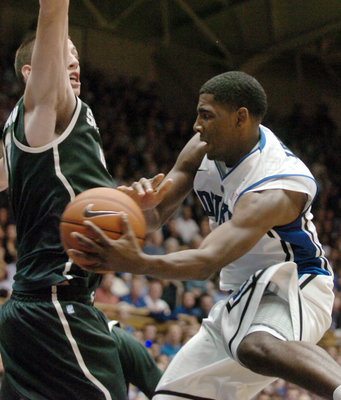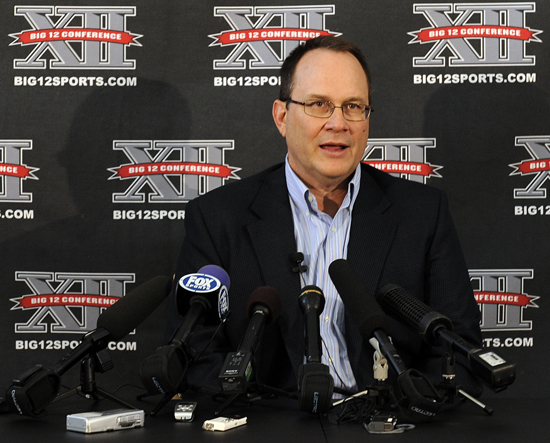Andrew Murawa is the RTC correspondent for the Pac-10 and Mountain West conferences and an occasional contributor.
With the news on Thursday that Utah has received and accepted the invitation to become the 12th member of the Pac-10, it looks like the college sports realignment apocalypse has been averted for the summer. There may be further movement on down the line, but all signs point to a relative period of calm after weeks of frantic scrambling from all corners of the country. While it was a pale substitute for actual on-court play, we did have plenty of intrigue and suspense, action and strategy, and winners and losers. Now it’s just a matter of sorting out who was what.
The Greatest and Still Champion
Texas

A Lot to Be Happy about in Austin These Days
Texas definitely fits in the “winner” category, but I think lumping them in with these other schmucks below would be selling them short. And I’m sure they would agree. The Longhorns played this about as well as could be played, and they got everything they wanted out of it. The Big 12 keeps their television deal with ESPN (which doesn’t expire until 2016), but only has to share the proceeds among ten schools rather than twelve. The conference received a promise from Fox for a new deal when their current deal expires, with exponential increases in revenue on tap. And, on top of all that, Texas retains the right to sell local television rights and is free to explore its plans for a Longhorn television network. Bonus: in the process of trying to keep the Longhorns in the Big 12, there are reports that the neediest institutions in the bunch agreed to a plan that sent all of the money that Colorado and Nebraska owe the conference in buyout fees (reported to be somewhere between $10 and $40 million, depending on the source) to Texas, Texas A&M and Oklahoma. So, in the span of a week, without losing any of their traditional rivals in the Big 12 South, Texas goes from generating somewhere in the $12 million range in television revenues to earning an estimated $20-25 million annually. And, that’s not even the best of it. In the process, it became painfully obvious that Texas is the big dog in the conference and the other schools (aside from Texas A&M) are in some manner, just riding coattails. Schools like Oklahoma and Texas Tech made it clear that they were just going to do whatever Texas did, while others, like Missouri, Kansas, Iowa State and Baylor, had their futures twisting in the wind, reliant on Texas to save them. If the Longhorns had gone to the Pac-16, they would have just been one of the sixteen there. By staying at home, they are clearly the kings of their conference.
The Winners
Texas A&M
The Aggies showed themselves as the one school in the conference that had plans of their own regardless of Texas. While Oklahoma and others were happy to just do whatever Texas decided, A&M talked to the SEC, and by all reports, actually had an offer to join that conference. But, in the end when they could have run off and forced Texas’ move west, the Aggies agreed to stick around and share in the league’s windfall, excellent news for an athletic department that was $16 million in debt, and even better for a school whose once proud football program has fallen on hard times in the past decade.
Big 12 Basketball
Without a doubt, the Big 12 became a better basketball conference overnight. Over the last nine years, both Colorado and Nebraska have had an average finish of around ninth in the conference. Nebraska has never won an NCAA tournament game. Colorado has only had two NCAA tournament berths in the last 40 years. So as far as the basketball side of the equation goes, this is addition by subtraction at its finest. As the conference makes the transition to an 18-game schedule in which each team will play a full home-and-home round-robin, they will no longer have to worry about games against the Buffs or Huskers dragging down their RPI. Every night in the conference will be tough sledding, but every team in the conference will also have a better chance to build their resume for postseason play.

Watch Out, Big East and ACC...
Chip Brown and Orangebloods.com
Chip Brown has been the point-man on conference realignment for about two weeks now. He broke the original story about Texas dragging five other Big 12 schools to the Pac-10, and when Texas blinked in the 11th hour, it was Brown who had that story first as well, even in the face of ESPN reporting the opposite. In the process, Brown, a former writer for the Dallas Morning News, has seen his Twitter followers increase exponentially, and the profile of Orangebloods.com, a Longhorn Rivals site of which he is part owner, has jumped from something that was only known amongst the most attentive Longhorn fans to an important resource for those of us following this story.
Utah
The Utes received just $1.2 million in television revenue from their association with the Mountain West Conference. Presently Pac-10 schools earn somewhere in the $10-$12 million neighborhood from their television contracts, and with the Pac-10 set to negotiate a new television deal which will begin the 2011-12 season, the Utah athletic department stands to make a nice chunk of change for very little trouble. While the basketball program is going through a rough patch presently, it wouldn’t surprise anyone to see the Utes be right in the thick of things in the Pac-10 football chase immediately.
ABC/ESPN and Fox Sports
Both networks stepped in to help save the Big 12. ABC/ESPN agreed to keep their current contract with the Big 12, allowing the ten remaining members to split the revenues that had previously been divided amongst twelve. Fox Sports also agreed to large increases in their agreement with the Big 12 which expires next offseason. If Texas had bolted for the Pac-10 along with five other Big 12 members, both ESPN and Fox Sports would have had a major bidding war on its hands for the rights to the new Pac-16 conference television deal. The breakup of the Big 12 would likely have meant other moves by the Big Ten or SEC or ACC, moves that could have resulted in their contracts needing to be reworked. In the short term, both entities probably overpay for the Big 12 rights, but they saved themselves plenty of cash in the long term.
Big Ten
While it may have appeared to be the first rat on the way out before the ship went down, Nebraska’s move to the Big Ten makes a lot of sense, at least football-wise. Adding the Huskers gives the Big Ten four iconic football programs, the ability to hold a championship game and a fanbase that will eat up anything Huskers on the Big Ten Network. And, passing on Missouri is probably the right move as well. Picking up one Big 12 team brings the Big Ten to 12 schools, and allows them to take their time with any additional expansion they may be interested in, while getting the benefits of the 12th team. If the Big Ten chooses to pursue further expansion, it will be mostly focused on Big East teams, including the great white whale, Notre Dame.
The Losers
Missouri
Read the rest of this entry »

















































